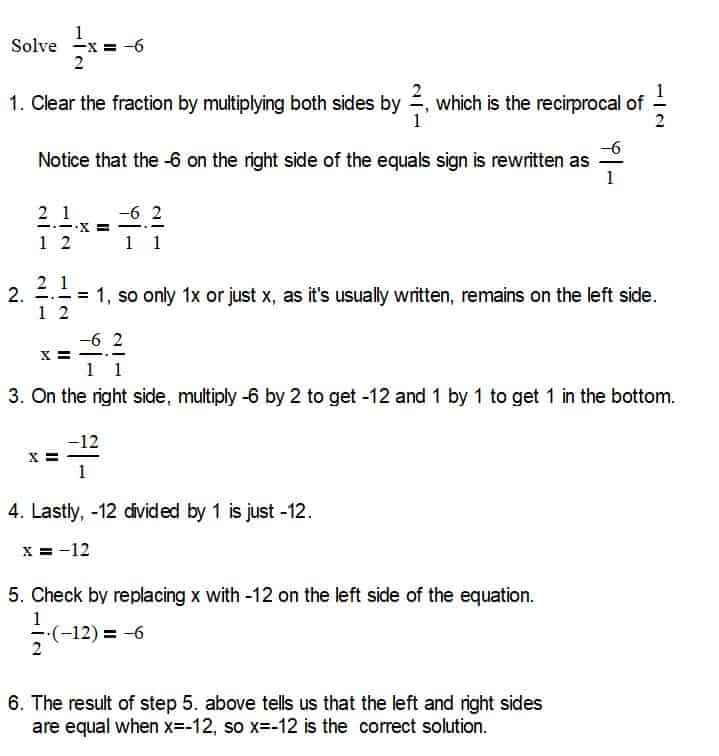Solving Linear Equations: A Step-by-Step Guide to \( \frac{1}{2}x = -6 \)
Understanding how to solve linear equations is a fundamental skill in algebra. In this example, we’ll walk you through solving the equation \( \frac{1}{2}x = -6 \) step by step.
Step 1: Write down the original equation: \( \frac{1}{2}x = -6 \).
Step 2: Multiply both sides by 2 to clear the fraction: \( 2 \times \frac{1}{2}x = 2 \times -6 \Rightarrow \cancel{2} \times \frac{1}{\cancel{2}}x = \cancel{2} \times -6 \Rightarrow x = -12 \).
Step 3: Check the solution by substituting back into the original equation: \( \frac{1}{2} \times -12 = -6 \).
Conclusion: The solution to the equation \( \frac{1}{2}x = -6 \) is \( x = -12 \). This step-by-step guide to solving linear equations demonstrates the process of isolating the variable to find the solution.
Solving Linear Equations: A Step-by-Step Guide to \( \frac{3}{4}y = 9 \)
Continuing our exploration of solving linear equations, we present a step-by-step guide to solving the equation \( \frac{3}{4}y = 9 \). Follow along to understand the process.
Step 1: Write down the original equation: \( \frac{3}{4}y = 9 \).
Step 2: Multiply both sides by 4 to clear the fraction: \( 4 \times \frac{3}{4}y = 4 \times 9 \Rightarrow \cancel{4} \times \frac{3}{\cancel{4}}y = \cancel{4} \times 9 \Rightarrow 3y = 36 \).
Step 3: Divide both sides by 3 to solve for y: \( \frac{3y}{3} = \frac{36}{3} \Rightarrow \cancel{3}y/\cancel{3} = 12 \Rightarrow y = 12 \).
Step 4: Check the solution by substituting back into the original equation: \( \frac{3}{4} \times 12 = 9 \).
Conclusion: The solution to the equation \( \frac{3}{4}y = 9 \) is \( y = 12 \). This example further illustrates the method of solving linear equations by isolating the variable.
Solving Linear Equations: A Step-by-Step Guide to \( \frac{5}{6}z = 10 \)
Mastering the art of solving linear equations is essential in mathematics. In this example, we’ll guide you through solving the equation \( \frac{5}{6}z = 10 \) step by step.
Step 1: Write down the original equation: \( \frac{5}{6}z = 10 \).
Step 2: Multiply both sides by 6 to clear the fraction: \( 6 \times \frac{5}{6}z = 6 \times 10 \Rightarrow \cancel{6} \times \frac{5}{\cancel{6}}z = \cancel{6} \times 10 \Rightarrow 5z = 60 \).
Step 3: Divide both sides by 5 to solve for z: \( \frac{5z}{5} = \frac{60}{5} \Rightarrow \cancel{5}z/\cancel{5} = 12 \Rightarrow z = 12 \).
Step 4: Check the solution by substituting back into the original equation: \( \frac{5}{6} \times 12 = 10 \).
Conclusion: The solution to the equation \( \frac{5}{6}z = 10 \) is \( z = 12 \). This step-by-step guide to solving linear equations provides a clear path to finding the value of the variable.

